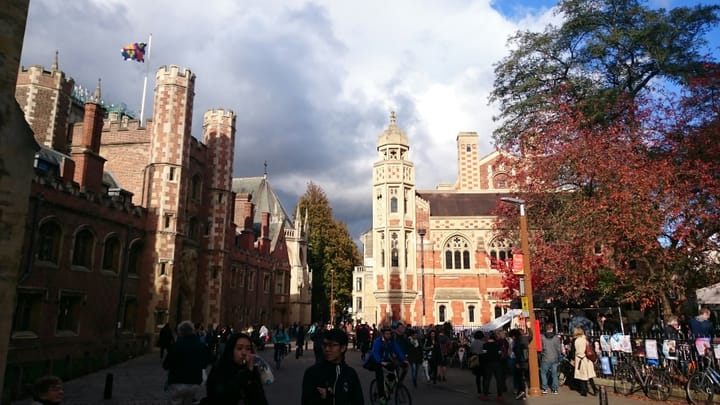The University of California Statistics Department; where mean is normal, and deviation standard.
The chipped Formica of the departmental coffee station felt cool under Professor Anya Sharma’s elbows as she surveyed the morning chaos

The chipped Formica of the departmental coffee station felt cool under Professor Anya Sharma’s elbows as she surveyed the morning chaos. The University of California Statistics Department; where mean is normal, and deviation standard. It wasn’t just a department motto, plastered ironically above the whiteboard covered in Greek letters and half-erased equations, it was a way of life. A guiding philosophy, and, lately, a coping mechanism.
This semester felt…different. Not the usual influx of bright-eyed undergraduates seeking to unlock the secrets of data, nor the frantic energy of PhD candidates bracing for qualifying exams. This was an undercurrent of anxiety, a palpable buzz that hummed beneath the surface of calculated probabilities and rigorous proofs. It began with the “Outlier Incident,” as it had been discreetly, almost reluctantly, dubbed.
Dr. Alistair Finch, the department’s resident Bayesian guru, had published a pre-print, a working paper released online before peer review. The paper, titled “Predictive Modeling of Existential Dread Using Nonlinear Dynamical Systems,” was… unusual, even for Finch. It wasn't the complex methodology that raised eyebrows; Finch was known for his complexity. It was the results.
He’d posited, and allegedly modeled, a statistically significant correlation between the consumption of overly-sweetened pumpkin spice lattes and a measurable increase in localized philosophical despair. Furthermore, his model predicted a forthcoming “Spiritual Collapse Event” centered specifically around the campus coffee shops sometime within the next two weeks.
The paper was immediately savaged. Not on methodological grounds – Finch’s math was airtight, agonizingly so – but on grounds of, well, absurdity. “Correlation does not equal causation,” a scathing blog post from a rival institution pointed out with brutal simplicity. “Seriously?” was the headline of the departmental newsletter’s brief mention.
But then… things started happening. Students did seem more listless. The lines at the campus coffee shops, already legendary, grew longer, filled with hushed, melancholic conversations. A student protest movement, “Existential Equity Now,” materialized with baffling speed, demanding better mental health resources and a moratorium on pumpkin spice anything. Even Professor Davies, the staunch, rational frequentist, admitted to feeling “a certain… flatness” after his morning cappuccino.
The department was paralyzed. Had Finch stumbled upon something genuine, hidden in the noise? Was the collective anxiety feeding itself, becoming a self-fulfilling prophecy? Or was Finch, a man whose social skills were demonstrably below the standard deviation of the population, simply inept at interpreting, or even understanding, human behavior?
“It’s a Type I error on a societal scale,” muttered Dr. Ramirez, meticulously cleaning the lens of her telescope – a strange hobby for a statistician, but Ramirez specialized in astronomical outliers. “We’re declaring significance where none exists, just because we're… noticing it.”
Anya, however, wasn’t so sure. She’d spent hours poring over Finch’s data. The model itself was a masterpiece, albeit a disturbing one. She suspected Finch hadn't intended to predict an apocalypse, but rather to highlight the inherent fragility of happiness, measured, of course, in quantifiable units.
The problem wasn't the model, she believed, but the context. The university was under immense pressure. Budget cuts loomed. Grad student funding was a disaster. The football team was having a historically bad season. Maybe Finch's model simply illuminated pre-existing cracks in the collective psyche.
“We need to run a control group,” Anya announced at the emergency faculty meeting, held, naturally, in the department’s perpetually overcrowded seminar room. “Students from other universities, similar demographics, exposure to similar levels of pumpkin spice. We need to see if this effect is localized, or… widespread.”
Professor Davies scoffed. “Waste of time. It’s Finch. He’s lost it.”
“We have a professional obligation to investigate,” Anya countered, her voice firm. “We preach objectivity, we must practice it.”
The meeting dissolved into a fractious debate, punctuated by the clatter of lukewarm coffee mugs. The "Spiritual Collapse Event" deadline loomed. The department, dedicated to quantifying everything, found itself grappling with something it couldn’t quite categorize, something that defied easy calculation. In the University of California Statistics Department, where mean was normal, and deviation standard, the world was suddenly, unsettlingly, skewed. And the air, even without the pumpkin spice, smelled faintly of dread.


